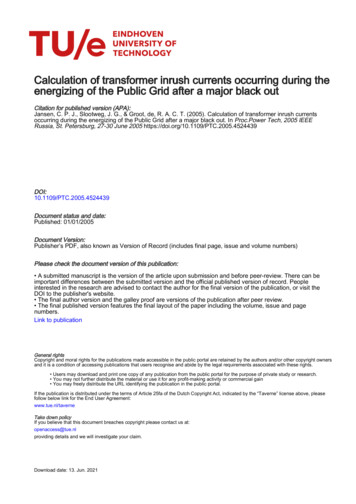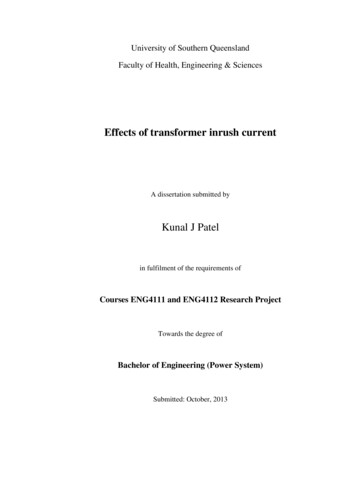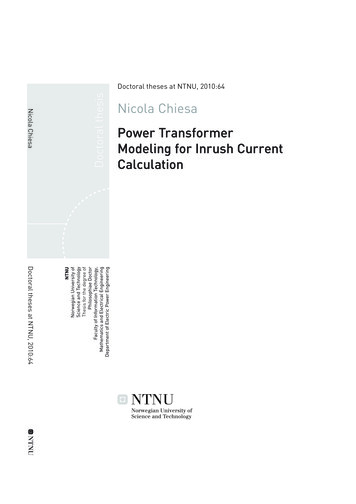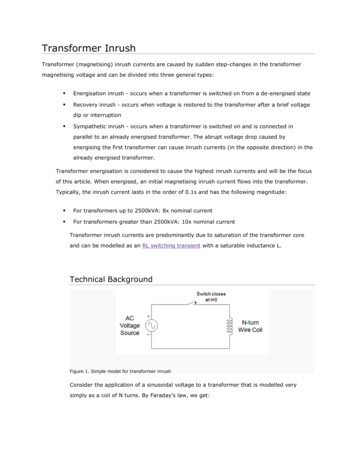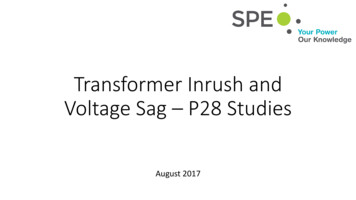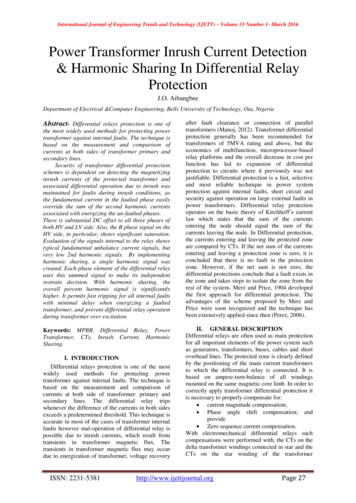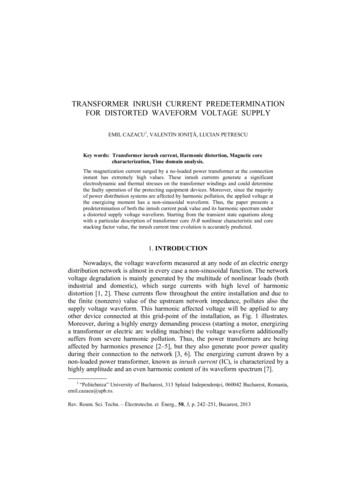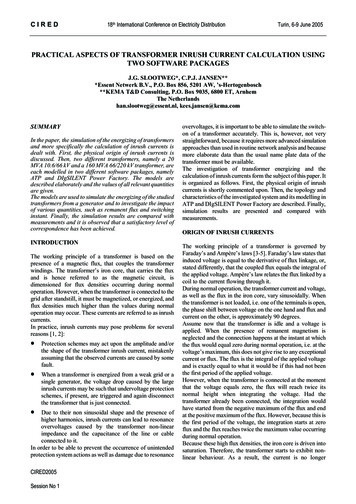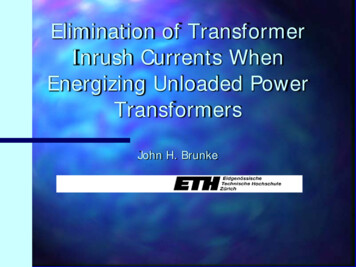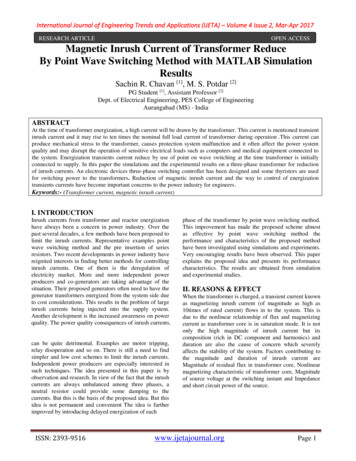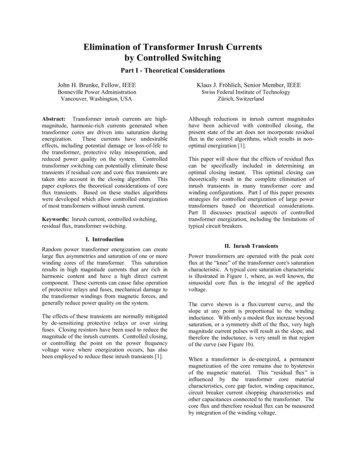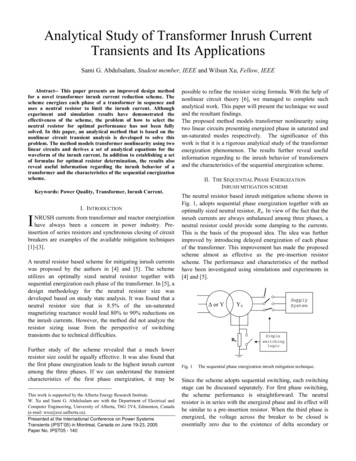
Transcription
Analytical Study of Transformer Inrush CurrentTransients and Its ApplicationsSami G. Abdulsalam, Student member, IEEE and Wilsun Xu, Fellow, IEEEAbstract-- This paper presents an improved design methodfor a novel transformer inrush current reduction scheme. Thescheme energizes each phase of a transformer in sequence anduses a neutral resistor to limit the inrush current. Althoughexperiment and simulation results have demonstrated theeffectiveness of the scheme, the problem of how to select theneutral resistor for optimal performance has not been fullysolved. In this paper, an analytical method that is based on thenonlinear circuit transient analysis is developed to solve thisproblem. The method models transformer nonlinearity using twolinear circuits and derives a set of analytical equations for thewaveform of the inrush current. In addition to establishing a setof formulas for optimal resistor determination, the results alsoreveal useful information regarding the inrush behavior of atransformer and the characteristics of the sequential energizationscheme.Keywords: Power Quality, Transformer, Inrush Current.I. INTRODUCTIONINRUSH currents from transformer and reactor energizationhave always been a concern in power industry. Preinsertion of series resistors and synchronous closing of circuitbreakers are examples of the available mitigation techniques[1]-[3].A neutral resistor based scheme for mitigating inrush currentswas proposed by the authors in [4] and [5]. The schemeutilizes an optimally sized neutral resistor together withsequential energization each phase of the transformer. In [5], adesign methodology for the neutral resistor size wasdeveloped based on steady state analysis. It was found that aneutral resistor size that is 8.5% of the un-saturatedmagnetizing reactance would lead 80% to 90% reductions onthe inrush currents. However, the method did not analyze theresistor sizing issue from the perspective of switchingtransients due to technical difficulties.Further study of the scheme revealed that a much lowerresistor size could be equally effective. It was also found thatthe first phase energization leads to the highest inrush currentamong the three phases. If we can understand the transientcharacteristics of the first phase energization, it may beThis work is supported by the Alberta Energy Research Institute.W. Xu and Sami G. Abdulsalam are with the Department of Electrical andComputer Engineering, University of Alberta, T6G 2V4, Edmonton, Canada(e-mail: wxu@ece.ualberta.ca).Presented at the International Conference on Power SystemsTransients (IPST’05) in Montreal, Canada on June 19-23, 2005Paper No. IPST05 - 140possible to refine the resistor sizing formula. With the help ofnonlinear circuit theory [6], we managed to complete suchanalytical work. This paper will present the technique we usedand the resultant findings.The proposed method models transformer nonlinearity usingtwo linear circuits presenting energized phase in saturated andun-saturated modes respectively. The significance of thiswork is that it is a rigorous analytical study of the transformerenergization phenomenon. The results further reveal usefulinformation regarding to the inrush behavior of transformersand the characteristics of the sequential energization scheme.II. THE SEQUENTIAL PHASE ENERGIZATIONINRUSH MITIGATION SCHEMEThe neutral resistor based inrush mitigation scheme shown inFig. 1, adopts sequential phase energization together with anoptimally sized neutral resistor, Rn. In view of the fact that theinrush currents are always unbalanced among three phases, aneutral resistor could provide some damping to the currents.This is the basis of the proposed idea. The idea was furtherimproved by introducing delayed energization of each phaseof the transformer. This improvement has made the proposedscheme almost as effective as the pre-insertion resistorscheme. The performance and characteristics of the methodhave been investigated using simulations and experiments in[4] and [5]. or YRnFig. 1SupplySystemYgSimpleswitchinglogicThe sequential phase energization inrush mitigation technique.Since the scheme adopts sequential switching, each switchingstage can be discussed separately. For first phase switching,the scheme performance is straightforward. The neutralresistor is in series with the energized phase and its effect willbe similar to a pre-insertion resistor. When the third phase isenergized, the voltage across the breaker to be closed isessentially zero due to the existence of delta secondary or
three-legged core. So there are no switching transients forwhen the 3rd phase is energized [4] and [5].The 2nd phase energization is the one most difficult to analyze.Fortunately, we discovered from numerous experimental andsimulation studies that the inrush current produced from 2ndphase energization is smaller than that produced from 1stphase energization (when Rn is relatively small). Thisphenomenon is shown next and will be discussed in SectionIV. The important conclusion at present is that the first phaseenergization should be the focus point for developing theoptimal Rn formula. Experimental and simulation results of theImax-Rn curves, representing the impact of Rn on the maximuminrush current of all phases, are shown in Fig. 2 and 3respectively for a laboratory transformer 30kVA, 208/208, 3limb, with Yg- connection.computer simulation for neutral resistor sizing on a case-bycase basis. Very few investigations in this field have beenmade and some formulas were given to predict the generalwave shape, harmonic content or the maximum peak current[1], [6], [7], [8] and [9]. In most cases, the series impedancewith the energized transformer ‘resistive and reactive’ hasbeen neglected. For the presented application, it was requiredthat the expression can accurately present the inrush currentwaveform taking into account system impedance, residual fluxvalue and of course the neutral resistor itself.The transformer behavior during first phase energization canbe modeled through the simplified equivalent electric circuitshown in Fig. 4 together with an approximate two-slopesaturation curve.1000Imax 1stInrush Current [Amp]800Imax 2ndImax 3rd600400200(a)0012345678910Neutral Resistor [Ohm]Fig. 2 Magnitude of inrush current as affected by the neutral resistor for a30kVA, 208/208, Yg- , 3 limb transformer. (Expiremental)1000λLsλsLmImax 1stInrush Current [Amp]800Imax 2ndImax 3rd600isim(b)400Fig. 4 (a) Transformer electrical equivalent circuit (per-phase) referred to theprimary side. (b) Simplified, two sloped saturation curve.2000012345678910Neutral Resistor [Ohm]Fig. 3Maximum inrush current as affected by the neutral resistor for a30kVA, 208/208, Yg-D, 3 Limb transformer. (Simulation)It can be seen that the maximum inrush current associatedwith the second phase energization is lower than that of thefirst phase energization for the same value of Rn. This is truefor the region where the inrush current of the first phase isdecreasing rapidly as Rn increases. As a result, we shouldfocus on analyzing the first phase energization to develop amore precise selection method for the neutral resistor.III. ANALYTICAL EXPRESSION FOR INRUSH CURRENTAn accurate analytical expression for inrush currents will leadto a solid design methodology for the neutral resistor size andmore understanding of the scheme transient performance. Theanalytical expression will also eliminate the requirement ofAs shown in Fig.4(a), rp and lp present primary resistance andleakage reactance. Lm(i) represents the nonlinear inductance ofthe iron core as function of the magnetizing current.Secondary side resistance rsp and leakage reactance lsp asreferred to primary side are also shown. Vp and Vs representthe primary and secondary phase to ground terminal voltagesrespectively. During first phase energization, the differentialequation describing the behavior of the saturable iron coretransformer can be written as follows;di dλ dt dtdi dλ div p ( t ) ( r p R n ) i (t ) l p dt di dtv p (t ) ( r p R n ) i (t ) l p (4)The rate of change of flux linkages with magnetizing currentdλ di can be represented as an inductance equal to the slope
of the λ-i curve. Eqn. (4) can be re-written as follows;v p ( t ) ( r p R n ) i (t ) l p didi Lcore (λ ) dtdt(5)Figure 5 shows the first cycle, analytical and simulationwaveform for the 30kVA transformer using neutral resistorvalues of 0.1, 0.5 and 1.0 [Ohm] respectively and a residualflux of 0.75 [p.u.]. Analytical and simulation results wereobtained using the transformer data given in the appendix.The general solution of the differential equation (5) can befound through presenting the core nonlinear inductor inFig.4.a as a linear inductor in un-saturated ‘Lm’ and saturated‘Ls’ modes of operation, Fig 4.b.tsλs Vm sin(ω t )dt λo(6)01t s (λo ) ω cos 1 (1 (λ s λo ) λ n )(7)Where: λn nominal peak flux linkages.ω angular frequency.Vm nominal peak supply voltage.Rn 0.1 [Ohm] (Analytical)Rn 0.1 [Ohm] (Simulation)900Rn 0.5 [Ohm] (Analytical)Rn 0.5 [Ohm] (Simulation)Current [Amp]Transformer performance during energization in unsaturatedmode ‘for each phase’ will determine the time at which eachphase will reach saturation first, depending on the switchingangle and the amount of initial flux linkages λo. Generally, theinitial ‘or residual’ flux will be below the saturation flux leveland accordingly, the apparent magnetizing impedance will bevery high compared to other linear elements in the seriescircuit. As a result, when the transformer is energized and λois below λs, the total supply voltage will be mainly distributedacross the magnetizing branch until saturation is reached. Thesaturation time ‘ts’ can be calculated as time required for theintegral of the supply voltage added to the initial flux ‘λo’ toreach the saturation flux λs. Hysteresis effect ‘usuallypresented as a resistance in parallel with the magnetizingreactance’ will not affect estimation of the saturation time ts.1100700Rn 1.0 [Ohm] (Analytical)Rn 1.0 [Ohm] (Simulation)500300100-1000 A1 e -t/τ1 B1 sin (ω t θ 1 ) i (t ) - ( t t s ) /τ 2 B2 sin (ω t θ 2 ) (i s A2 ) et ts(8)t tsVm2p2A1 B1 sin (θ1 ) ω (Lm l p ) r p Rn θ 1 tan 1 is isλo 0 (1 λ o λ s )B2 (rVm Rn ) (ω (Ls l p ))2p2A2 B2 sin (θ 2 ω t s ) ω (Ls l p ) rp Rn θ 2 tan 1 τ1 0.0080.010.012Fig. 5 Analytical and simulation inrush current waveforms (first cycle) for30kVA Yg- transformer.Equation (8) can be further simplified to find the most severeinrush current peak as function of neutral resistor value duringfirst phase switching. A switching angle of zero with amaximum residual flux of the same polarity as the appliedsinusoidal will result in the maximum inrush current. Thesaturation current ‘is’ will be very small as compared to inrushcurrent peak and can be neglected. It can also be assumed thatthe inrush peak value will exist during saturation when thesinusoidal term peaks. This assumption is valid since the timeconstant during saturation,τ2(Rn), is small as Rn increaseswhich will introduce a small shift in the peak current to appearslightly before the sinusoidal peak value. The peak time canbe expressed as;Lm l prp Rnτ2 t peak (Rn ) n2nπ 2 θ2 (Rn )ωLs l prp Rn(9)The simplified inrush current peak during first phaseenergization as function of Rn can be expressed as follows.I peak (Rn ) A2 eWhere: Rn ) (ω (Lm l p ))0.006Time [sec.]peak(r0.004(ω t (R )-θ (R )) π 2After saturation is reached at t ts, the core inductance will beswitched-in to equal the saturation inductance Ls with aninitial saturation current is.B1 0.002- ( t peak t s ) /τ 2 B2(10)Equation (10) was found to be very accurate as compared tosimulation results. The Ipeak(Rn) ‘analytical’ and the Imax-Rncurves for the 30kVA lab transformer are shown in Fig. 6. It isclear that the Ipeak(Rn) equation can accurately determine themaximum inrush peak current for a given residual level andusing only the simplified two slope saturation curve.
Rn. Actually, due to the phase difference in the supply voltage,the amount of disturbance in phase A flux will be less than thereduction in flux achievable in the switched phase B. Also, asthe difference between the saturation and rated flux valueincreases, more reduction in phase B current can be achieved.The same conditions also apply during third switching stage.500Maximum Inrush Current Neutral Resistor, Rn [Ohm]Fig. 6. Ipeak(Rn) compared to the simulation peak current for 30 kVA, 208/208Yg- , three limb transformer.Sizing the neutral resistor based on Eqn. (10) and close to theknee of the Imax(Rn) curve will insure a reduction of 80-90% ofinrush current in all three phases as compared to the inrushmagnitude with a solidly grounded connection, Rn 0.IV. SECOND PHASE SWITCHINGTransformer behaviour during second phase switching wasobserved through simulation to vary with respect toconnection and core structure type. Transformers with deltaconnected secondary or having multi limb structure havedifferent behaviour during the second phase switching fromthat of single phase units without a delta winding. However, ageneral behaviour trend exists during the second switchingstage for all transformer connections and core types for lowneutral resistor values. In this section, the performance of theproposed inrush mitigation scheme during second stageswitching will be discussed for small values of Rn.B. Transformers with delta winding and/or 3-Limb structuresFor transformers of this type, the performance duringsequential switching will be quite different than the singlephase Yg-Y transformers for the following reasons:-Dynamic Flux will exist in un-energized phases.Inrush current can exist in one phase due to externalsaturation in un-energized ph
Keywords: Power Quality, Transformer, Inrush Current. I. INTRODUCTION NRUSH currents from transformer and reactor energization have always been a concern in power industry. Pre-insertion of series resistors and synchronous closing of circuit breakers are examples of the available mitigation techniques [1]-[3]. A neutral resistor based scheme for mitigating inrush currents was proposed by

